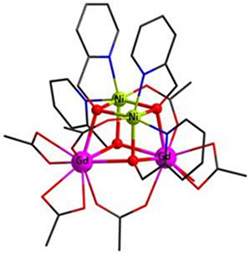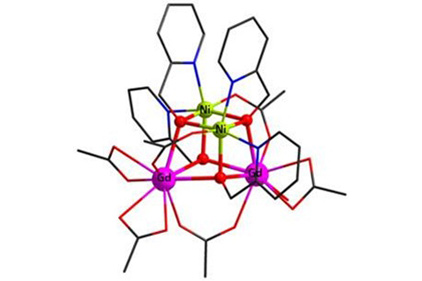Researchers at the A*STAR Institute of Materials Research and Engineering and the National University of Singapore believe they have created a powerful magnetic refrigerant that is easy to make in the lab, reports the nanotechnology journal nanowerk.

|
| Cubane cluster for magnetic refrigeration. |
The researchers “simply mixed gadolinium acetate, nickel acetate and an organic molecule called 2-(hydroxymethyl) pyridine in an organic solvent at room temperature,” reports nanowerk. The magnetic refrigerant contains a cubic structure made of two gadolinium ions, two nickel ions, and four oxygen atoms, surrounded by 2-(hydroxymethyl) pyridine molecules — see image (courtesy A*STAR Institute of Materials Research and Engineering).
Magnetic refrigerants commonly use the gadolinium (III) ion (Gd3+), because it has seven unpaired electrons. Most gadolinium complexes are made under harsh conditions or take a very long time to form, which limits their wider application. In contrast, this new magnetic refrigerant is “remarkably easy to make,” nanowerk reports.
After 12 hours, the chemicals had assembled themselves into an aggregate containing a cube-like structure of atoms at its heart. The team measured how an external magnetic field affected this “cubane” material as the temperature dropped. Below about 50 K, they found that the material’s magnetization increased sharply, suggesting that it could be an effective magnetic refrigerant below this temperature.
The scientists then tested the effects of varying the external magnetic field at very low temperatures. They found that at 4.5 K, a large external field caused an entropy change that was close to the theoretical maximum for the system — and larger than most other magnetic refrigerants under similar conditions. According to the team, the magnetocaloric effect of magnetic refrigerants has typically been enhanced by creating ever-larger clusters of metal atoms. In contrast, their cubane shows that much simpler aggregates, prepared under straightforward conditions, are promising as magnetic refrigerants.
Content for the European Spotlight is provided courtesy of Refrigeration and Air Conditioning Magazine, London. For more information, visit www.racplus.com.
Publication date: 10/20/2014
Want more HVAC industry news and information? Join The NEWS on Facebook, Twitter, and LinkedIn today!


Report Abusive Comment